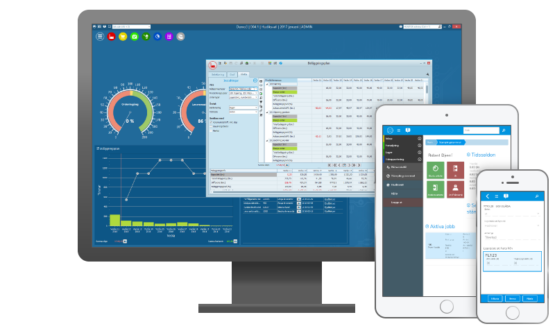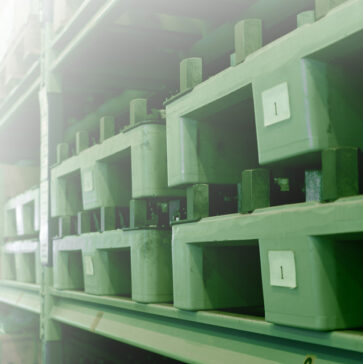
MONITOR ERP
MONITOR ERP - ideal software for small and medium-sized manufacturing companies.
MONITOR ERP software helps to conveniently manage all processes of a manufacturing company, starting with production, sales, purchasing, warehouse and ending with financial management.
MONITOR ERP sai neljandat aastat järjest kõrgeima tulemuse tootmisettevõtetele mõeldud ERP tarkvarade võrdluses.
More Monitor ERP news on their own website.
This is the core of MONITOR. The system is optimized for manufacturing and production planning. Here you can create BOM and routing, perform important calculations, and register manufacturing orders that will generate profit. Your loading plans can be controlled here. You can report and print pick lists, manage pool planning, and use coordinated processing. We provide all the tools necessary to help you succeed in your line of business.
- BOM and Routing
- Pre-calculation
- Post-calculation
- Manufacturing Order
- Loading Plans in Lists and Charts
- Pick Lists for Material
- Operation and Material Reporting
- Manage Subcontracts
- Pool Planning
- Coordinated Processing
BOM and Routing
BOM and routing is one of the most fundamental functions in an ERP system such as MONITOR. Here you can add and update operation lists and bills of material (BOM) for parts. The data entered here, such as operation times, quantities, lead times, prices, etc., is key information which is applied throughout the entire system. The information from BOM
and routing is used in calculations, requirement calculations, and loading plans.
Pre-calculation
The main purpose of pre-calculation is to perform financial calculation of manufacturing cost, cost price, and sales price for product structures. Costs consisting of material, sub-contracted work, and your own work are added together to generate a total manufacturing cost. This forms the basis of reconciliation/balancing against actual cost – the post-calculation.
Post-calculation
The main purpose of post-calculation is to perform financial follow-up after a part/an order has been manufactured/reported. Here you can compare planned costs with actual costs to find out if things turned out as planned.
Manufacturing Order
Here you can create new manufacturing orders as well as re-plan or delete existing orders. You can change and re-plan main information as well as the order structure. You can also print linked order documents, such as drawings.
Loading Plans in Lists and Charts
It's important to have an overview of production. Is your capacity sufficient at present? What about tomorrow? Or a week from now? You can easily manage your loading plans in lists or charts, in which you can drag and drop your orders.
Pick Lists for Material
Documents can easily be printed. You can also see which material needs to be picked from stock for a manufacturing order when using the mobile application. If material has several locations, you'll only see the locations that are needed to pick the material. If you have already performed material clearance (booked material), these locations will be shown. Otherwise, locations are suggested according to age analysis in MONITOR. If a part appears several times in the same pick list, the deduction is made according to the requirement date, so that the material row that is needed first is withdrawn from the oldest location. When the disposable balance of that location is zero, the material row continues to make withdrawals from the second-oldest location, and so on.
Operation and Material Reporting
It's easy to report time and quantity for one operation at a time by entering the report number of the operation. If you need to perform partial reporting, each report is totaled in terms of both quantity and time. Loading is balanced in proportion to the reported quantity. In the same way, you can easily report quantity for one material at a time, by entering the report number of the material. When carrying out partial reporting for the material, the system adds up the quantity of each partial report that is logged. The remaining quantity (that reserves material) is deducted by the corresponding quantity that was reported.
Manage Subcontracts
Subcontracts are used to send work to subcontractors. You may not, for example, have the necessary machines or knowledge, or you could have a high workload at a particular time. MONITOR allows you to easily subcontract part of your production if required. When a manufacturing order including a subcontract is created in MONITOR, a subcontract purchase order is automatically generated. This also applies if an existing manufacturing order is re-planned, or an internal operation is re-planned and placed with a subcontractor when there is a lack of capacity. It's easy to follow up on subcontract costs and lead times in MONITOR, which makes it possible for you to control your manufacturing order flow.
Pool Planning
Do you have several machines of the same type on your production floor? Then our pool planning facility may be of interest. When you create BOM and routing, you may not always know which machine will perform the operation. You can then select a pool instead to which several equivalent machines are linked. You'll then delegate the work to one of the machines that is linked to the pool and has the capacity to perform the work. Delegation of work within the pool can be carried out manually, but also automatically, whereby MONITOR selects the most suitable machine for the work.
Coordinated Processing
Sometimes you have parts that should or could be manufactured at the same time as other parts, and you want to place orders for them at the same time. This is entirely possible in MONITOR. Suppose you punch two different parts - part A and part B - at the same time from the same sheet-metal unit. When using coordinated processing, the net requirement calculation will register orders for both part A and part B as soon as there is a shortage of one part. If you register an order manually for part A, the system will automatically register an order for part B as well. Coordinated parts are kept together as several main parts on an order, and the same applies when re-planning and deleting.


This module provides support for the entire purchase process, from inquiry to accounts payable. Here you can register suppliers, use SRM, create inquiries and purchase orders, perform arrival reporting, create transport labels, and perform receiving inspections to make sure everything is correct. You'll also register supplier invoices, manage accounts payable with invoice payments, and follow up on e.g. purchase statistics, supplier rating, and order backlog.
- Supplier Register with SRM (Supplier Relationship Management)
- Inquiry to Suppliers – Register, Send, Monitor
- Purchase Order
- Arrivals, Print Transport Labels, Receiving Inspection
- Register Supplier Invoices, Link to Purchase Order
- Accounts Payable with Invoice Registration and Outgoing Payments
- Follow-up using e.g. Purchase Statistics, Supplier Rating, and Order Backlog
Supplier Register with SRM (Supplier Relationship Management)
It's important to keep track of your suppliers. This is the engine of the purchase module, where you'll handle all communication and specific settings regarding your suppliers. It's easy to create activities, log activities, and email correspondence. MONITOR ensures the supplier is not included in any inquiries, purchase orders, invoices, accounts payable, supplier links, or subcontractors for work centers, before removing the supplier from the system.
Inquiry to Suppliers – Register, Send, Monitor
You want to know the price of a product and when it can be delivered.
tarnijatele, et valida enda jaoks parim pakkumine. Samuti saate värskendada või kustutada olemasolevaid päringuid. Päringu värskendamisel saate muuta selle olekut vastavalt tarnija vastusele või teisendada päringu ostutellimuseks (kas kogu päring või ainult soovitud read). Päringu saab kopeerida ka uude "seotud" päringusse, nt. kui soovite päringut üle vaadata või saata koopia teisele tarnijale.
Purchase order
Here you can control your purchase orders. You can create, modify, or delete existing orders.
This is very easy to do, and you can also create purchase orders in several different ways:
- You can create purchase orders manually.
- You can generate actual purchase orders from purchase order suggestions.
- You can create purchase orders from customer orders and manufacturing orders.
You can also load and edit purchase orders that have been created in another procedure, in order to e.g. add and delete order rows, change the quantity and delivery date, etc. This applies to purchase orders that have been created from manufacturing orders.
Arrivals, Print Transport Labels, Receiving Inspection
MONITOR makes it really easy to report arrival of material. You can search by several criteria during arrival reporting, such as your part number and order number, or a supplier's part number. Upon arrival, you can print transport labels and apply them to packaging before it is placed in stock. These include all the information you need.
You can also print transport labels in different sizes as well as select which information should be included in the transport label by editing it in MONITOR. For new suppliers, you may want to verify that you have received the correct products and quantities. You can then choose to perform receiving inspection of the new supplier. Sometimes you may want to inspect using certain intervals to assess whether the supplier continues to maintain the level expected. All of this is provided by the system.
Register Supplier Invoices, Link to Purchase Order
You can register new supplier invoices, modify existing invoices, and credit or cancel invoices. You can register debit invoices, credit invoices, and interest invoices. You can also final record invoices here. Registration of supplier invoices can either be carried out manually or by using invoices from XML files that are sent via email (MONITOR-to-MONITOR) from the supplier. These files can then be imported to the procedure. Several users can work in the procedure at the same time and register supplier invoices.
You can link purchase orders to supplier invoices, and see which purchase orders have been arrival reported for the selected supplier. The order rows will be shown for the purchase orders you have selected to include. You'll then select which order rows you want to link to the supplier invoice. For each order row, it is possible to update prices, discount, VAT code, and posting.
Accounts Payable with Invoice Registration and Outgoing Payments
In accounts payable, you can control all your incoming supplier invoices. The invoices are registered and linked to purchase orders for reconciliation. You can also send invoices for authorization. Payments can be manually handled with or without file transfer to your bank. Through different reports, you can check the status of all invoices and future outgoing payments.
Follow-up using e.g. Purchase Statistics, Supplier Rating, and Order Backlog
Using the business intelligence in MONITOR enables you to gain a clear overview of your purchase statistics. You may wish to view statistics for a specific time period, supplier, or part. You can also view supplier invoicing in a chart – or why not create a separate view which incorporates the information of interest to you.
This module contains all the procedures relating to sales of goods and services. Here you'll find procedures for customer management, prospective customers, CRM, quotes, customer orders, deliveries, invoicing, statistics and follow-up, accounts receivable, and cash flow forecasts.
- Customer Register with CRM functionality (Customer Relationship Management)
- Quotes – Register, Send, Monitor, and Convert to Actual Order
- Customer Orders – Register, Check Delivery Times, Confirm, Monitor
- Delivery Process with Pick Lists and Transport Management
- Invoices to Customer, Pro forma, and Invoicing Plans pro forma ja arveldusplaanid
- Accounts Receivable with Support for Incoming Payments, Payment Reminders, Interest Invoices, etc.
- Follow-up via e.g. Sales Statistics, Delivery Reliability, Cash Forecast
Customer Register with CRM functionality (Customer Relationship Management)
It's important to keep track of your existing and prospective customers. Here you'll find the core of your sales activities, where all communication is handled. It's easy to create and log activities and email correspondence. MONITOR also provides the tools required for highly efficient leads generation, where you can follow up on and see the outcome of fairs and exhibitions, or other events. You can also choose target groups that you want to communicate with before different events take place.
Quotes – Register, Send, Monitor, and Convert to Actual Order
Siin pakume teie hinnapakkumiste koostamiseks ja jälgimiseks vajalikku tuge. Samuti näete, millised hinnapakkumised muudeti tegelikeks tellimusteks. Hinnapakkumist on väga lihtne muuta kliendi tellimuseks. Professionaalse tulemuse saamiseks saate linkida oma hinnapakkumistele esilehe ja lisadokumente. Samuti on võimalik hinnapakkumiste malli vastavalt oma vajadustele muuta.
Customer Orders – Register, Check Delivery Times, Confirm, Monitor
Siin saate registreerida, muuta või ka kustutada olemasolevaid klienditellimusi. Klienditellimusi saab koostada ka hinnapakkumiste põhjal. Klienditellimuste koostamisel saab kasutada tarneaegade kontrollimise funktsiooni, mis hindab, millal saab tarne sooritada. Kui uus klienditellimus on registreeritud ja tellimuse kinnitus saadetud, saate tellimust jälgida, teha tarnearuandlust ja uuendada müügistatistikat. Mõjutatud on ka tellimuste planeerimine. Klienditellimuse tulemusena reserveeritakse laovarud vastavaks tarneperioodiks.
Klienditellimuste loomisel on jälgitavust lihtne kasutada. Samuti on lihtne luua uut tellimust olemasoleva põhjal, kasutades nuppu "Salvesta kui". Seejärel saate valida, kas soovite kopeerida tellimuse päise ja/või tellimuse ridu. Samuti saate uue tellimuse jaoks sisestada tellimuse kuupäeva.
Delivery Process with Pick Lists and Transport Management
It's important to keep track of your customer orders and stock orders for sales*. It is possible to deliver any optional orders or deliver orders via pick lists. This is determined by the selected list type. A customer order reported as delivered is updated at row level, and a new status is set on the order depending on whether partial delivery or delivery in full has been carried out. When the delivery is saved in this procedure, an invoice basis is created for delivered order rows and packaging. You can then print your delivery notes and transport labels, or send them via email. Shipping information is automatically calculated for the delivered quantity. As long as the invoice has not been printed, the delivery can be adjusted, either by reporting delivery of an additional quantity or undoing the delivery. When reporting an additional quantity, you can add it to an existing invoice basis.
* Stock order is available if you have installed the Warehouse option.
Invoices to Customer, Pro forma, and Invoicing Plans pro forma ja arveldusplaanid
An invoice basis is created when delivering customer order rows or registering invoices directly. Your pro forma invoices are handled in the same way.
In order to record COGS when invoicing, you'll also need to select the cost accounts and stock accounts that will be used per product group and customer group in each posting group. This system setting then determines if the accounts for material cost of goods sold (COGS) should be posted as cost accounts on the accounting order, with the stock account as offset account.
Arveldusplaane kasutatakse klientide tellimuste puhul juhtudel, kui soovitakse tellimuse eest arveldada täielikult või osaliselt, ette või tagantjärele. Arveldusplaan võiks olla näiteks 30% ettemaksuna, 60% üleandmisel ja 10% viivis pärast lõppkontrolli tegemist. Samuti saate kasutada arveldusplaane, kui soovite kogu tellimuse eest arveldada ette.
Accounts Receivable with Support for Incoming Payments, Payment Reminders, Interest Invoices, etc.
Accounts receivable provides details of customer invoices that have been sent. Incoming payments are received and registered manually or automatically via file transfer from the bank. You can also handle payment reminders and interest invoicing.
Follow-up via e.g. Sales Statistics, Delivery Reliability, Cash Forecast
By using the business intelligence provided by MONITOR you can gain a clear overview of your sales statistics. You may want to look at statistics for a specific time period, country, region, seller, customer, or part. You can also create a view which includes the information of interest to you. This view can then be selected by default, for you or for a specific department.
How reliable are your deliveries? The system helps you to keep track of your deliveries. You can also load cash flow forecasts of future incoming and outgoing payments. Information for these forecasts is retrieved from quotes, customer orders, and accounts receivable in the Sales module, and from purchase orders and accounts payable in the Purchase module. For invoicing plans, the delivery dates of the partial invoice rows are used when calculating cash flow. Data can also be loaded from manually registered incoming and outgoing payments such as salaries, VAT, etc.


This module enables effective and reliable requirements planning. You can see what’s in stock, and what it’s worth. Top quality traceability is also provided in this module, in addition to Case management and different stock calculations.
- Parts
- Requirements Planning
- Stock Count
- Stock Valuation
- Traceability
- Case Management
- Calculation
Parts
In MONITOR, all the basic data for parts is saved in one place. This data is then used in several different areas, such as the part register and different order registers. The part register is the most important and fundamental register in MONITOR, enabling users to load part lists with stock transaction logs as well as adjust part prices.
You can import new parts, annual budgets for purchase and sales, as well as part prices. Standard prices, supplier prices (also applies to subcontract parts), customer prices, and price lists can also be imported.
Requirements Planning
This is where you can identify parts for which a shortage is expected. In MONITOR, you can calculate order suggestions containing quantity and time/dates. Requirement calculations and net requirement calculations are also found here.
Net requirement calculations can be scheduled or run continuously. A continuous net requirement calculation only checks the parts that have been modified since the last net requirement calculation.
You can load sales forecasts that show expected sales. These forecasts are then used in requirements planning in order to see the requirement of quantities and delivery dates for parts.
Stock Count
Both continuous or complete stock counts can be performed. Continuous stock count is usually carried out according to a rolling schedule, whereby you stock count certain locations, part types, or departments at a time when production is still in progress. During a full/complete stock count, you'll usually count the entire stock at a time when production is not in progress, on a weekend, for example.
The stock balance of parts can then be moved between different locations. You can also move the balance from one location at a time and choose to distribute it to multiple locations simultaneously. It's also possible to create new locations when moving the balance.
You can report stock directly without having an order or project. A cause and a posting can be linked to the direct report.
Stock Valuation
Calculating the value of parts in stock is really easy. By using the Warehouse option, you can also value parts being transported between warehouses.
It's possible to calculate the value of work in progress (WIP), that is, the value of manufacturing orders in progress. The report can be used e.g. as a basis when recording the WIP value in accounting data, in connection with monthly or annual accounts. You can calculate the WIP value as a situation report for today's date, or for a selected time in the past.
Traceability
With secure and detailed traceability across every level of the processing flow, you'll minimize the number of products that have to be recalled if a nonconformity should occur.
You can trace/follow a serial number or a batch in each step of processing, beginning with arrival from the supplier. Traceability is also concerned with stating what is withdrawn from and added to stock, so this can later be traced from a customer order, via manufacturing order to purchase order. But it also involves being able to trace it the other way round; from purchase order via manufacturing order to customer order. Such tracking should be possible regardless of the level in the process flow.
Case management
This is where you can register and list cases when different nonconformities occur, from customer, to supplier, as well as internally. You can register default basic data for different nonconformity types, such as customer nonconformities or supplier nonconformities.
You can also create predefined phases or activities and costs for a case type, which are loaded into a new case. The default phases, activities, and costs configured per case type can be changed in connection with the registration of a new case.
It's possible to link substitute orders to cases. This enables you to plan, control, and follow up on these substitute orders. A substitute order can be a new order for a customer or supplier, a manufacturing order for an adjustment, or new manufacturing of internally manufactured parts.
Those responsible for different case activities can report their activities as they are started and finished. You can obtain an activity list to use as a basis for costs.
Süsteem võimaldab mõõta "tarneteabe" võtmenäitajat vastavalt klientidele ja tarnijatele. Seda saab kuvada diagrammina. Süsteem võimaldab luua ka allhankelepingute jaoks tarnijate reitinguid.
Calculation
The annual budget for parts can be calculated and updated. An annual budget is distributed based on a budget chart. There is also a function that is used to calculate and save annual volumes for parts. Data for the annual volume can be loaded in different ways, and the saving is applied either to the annual volume, or the annual volume at the current pace.
You can also calculate the parts’ safety stock, that is, at which stock balance a refill signal should be issued. The volume which should be ordered is determined by the part’s order quantity – which can also be calculated. The objective is to calculate an order quantity that will minimize the cost of stock holding and purchasing. This quantity is later used for requirements planning and calculations.
This procedure contains functions for attendance and work recording, basis for salaries, as well as functions for detail planning, schedules, etc.
- Recording
- Extended Personnel Records
- Recording Terminals
Recording
Personnel can record their attendance and work. Based on delegation and priority, they can choose which work to perform. The recording items are used as a basis for salaries and post-calculations. The recording terminal is available as a Windows client for PC, or a web client for use on any device, such as a tablet. Personnel can record work directly on their device next to the machine, so they don't have to walk to the other side of the workshop.
Attendance and work recording items can be adjusted if necessary. They can also be authorized using a separate function.
Palgabaasi - kirjete kirjendamise alusel - saab eksportida välistesse palgaarvestusprogrammidesse (selleks on vaja valikut Ekspordi palgabaasi). MONITOR toetab praegu PAXml, Agda ja Visma. Hogia on saadaval ka tulevikus.
Extended Personnel Records
This procedure enables creation of schedules and schedule cycles with basic data which is obtained from time recording. You can also link data such as salary types, absence codes, overtime types, etc. to attendance and work recording items.
Recording Terminals
You can configure how many recording terminals you wish to use, and whether they will allow attendance recording, work recording, or both. A further option is a specific terminal that only allows recording via card number/plastic card (magnetic stripe/nfc/chip).


This module enables you to manage your company’s current accounting. Here you'll find functions for handling accounts, automatic posting/allocation, current recording of transactions, reports and follow-up, as well as change of period/year. Project accounting can also be found here.
- Chart of Accounts, Dimensions, and Postings
- Accrual Accounting
- Current Accounting
- Budget
- Change of Period/Year
- Reports and Follow-ups
- Project Accounting
Chart of Accounts, Dimensions, and Postings
A regular chart of accounts is included as standard. If necessary, you can add new accounts to this chart of accounts. You'll register accounts to be used for current accounting and in procedures where posting of accounting orders is carried out.
Three dimensions are included: Cost center, Cost unit, and Project. However, you may add more dimensions if required (a maximum of eight dimensions can be used). For each dimension, several dimension codes can be added.
Headings and SRU codes for accounts in the chart of accounts are also included. These can be modified if necessary, and more headings and SRU codes can be added.
Automatic postings can be created which make it possible for the system to automatically perform several extra postings. By using automatic allocation, you can allocate an amount, for example, to different cost centers and cost units.
Accrual Accounting
Accrual accounting is used when you wish to distribute/allocate the recording of a total amount over a number of months. In normal cases, accrual accounting is created from other procedures in the system, for example, when registering supplier invoices or vouchers. Accrual accounting can also be created manually, and you can still link it to e.g. a supplier invoice or voucher.
The accrual accounting function can also be used to reverse a voucher in a future accounting period, for example, a closing record voucher which should be reversed next year.
Current Accounting
Kviitungeid saab luua automaatselt integreerimise teel või käsitsi jooksvas raamatupidamises. Võimalik on laadida olemasolevaid kviitungeid ja teha muudatusi. Varem registreeritud kviitungite korrigeerimiseks saate luua ka parandus- ja tagasipööramiskviiungeid. Samuti on võimalik kviitungeid kopeerida ja kirjendada tekkepõhiselt (järgmisel perioodil/aastal tagasipööratav kviitung). Saate luua oma tekstid, mida kasutada kviitungite registreerimisel ja maksete tegemisel. See hõlbustab registreerimist, kuna korduvaid tekste saab laadida, ilma et neid tuleks iga kord ümber kirjutada.
Budget
You can register new budgets or create budgets by copying data, for example, by copying budget and results from previous years. It is possible to register multiple parallel budgets for the same accounting year. You can configure how many budgets you would like to manage. The budget chart which is to be used is loaded from the chart of accounts upon registration. However, a different budget chart may be selected.
Change of Period/Year
In the Accounting module, it's easy to change accounting periods and transfer to a new accounting year.
When you start using MONITOR, you can manually import opening balances into your accounting data. It is also possible to import all accounting data via SIE files.
Reports and Follow-ups
In the general ledger, you can view all voucher rows, grouped per account or project. Balance brought forward and closing balance are shown for each grouping, and for the end of the selected time period. For balance sheet accounts, this year's opening balance is shown. Data is based on vouchers in accounting data, with links to, for example, chart of accounts, dimensions, projects, etc.
You can view balance information about one or more accounts in the active accounting year or a different accounting year. You can also see detailed information such as transactions, journals, and dimensions.
The following accounting reports are included: Balance reports (with or without dimensions), balance sheet, income statement, and budget of result. You can also create your own reports. VAT reports can be saved to a VAT report file which can be sent to the tax authority.
You can also load bases for reporting of EU statistics. In Sweden, this is called the EC sales list, and it is reported to Skatteverket (the Swedish Tax Agency).
Accounting transactions can be shown in chronological order. Each record shows when the transaction took place and which user performed the action – when the record was created, modified, or deleted.
Project Accounting
Projektiarvestus on integreeritud raamatupidamise moodulisse. "Projekt" on üldmõiste, mis hõlmab erinevaid tellimusi, tulusid, kulusid ja töötunde. Projekte on erinevat tüüpi, näiteks arendusprojektid, rekonstrueerimisprojektid või tootmisprojektid. Klienditellimuste vms postitamisel saate tootmistellimusse sisestada projekti numbri, et need kirjed projektiga siduda. Tegevusi saab registreerida ja hallata ka projektiarvestuses.
The costs, income, and hours of the project can then be followed up using cost types. These are loaded from different modules in the system. Budget, planned and ordered result, expected result, and forecast, can all be managed for each cost type/income type.
Projects also handle phases including different activities. Planned time, reported time, and remaining time can be managed for each activity. Activities can also be linked to cost types, which means the reported time is also recognized as a cost in the project.
In project accounting, you can also report costs, income, or time used directly in the project in cases where it is difficult to find these via customer orders. Separate activities can also be reported per user, directly in the project. You can also follow up on projects and hours that are linked to the projects.
We invite you to contact us to discuss ways in which we can work with your organization to achieve your business objectives. We will rock you!
Do you want Monitor ERP training?

